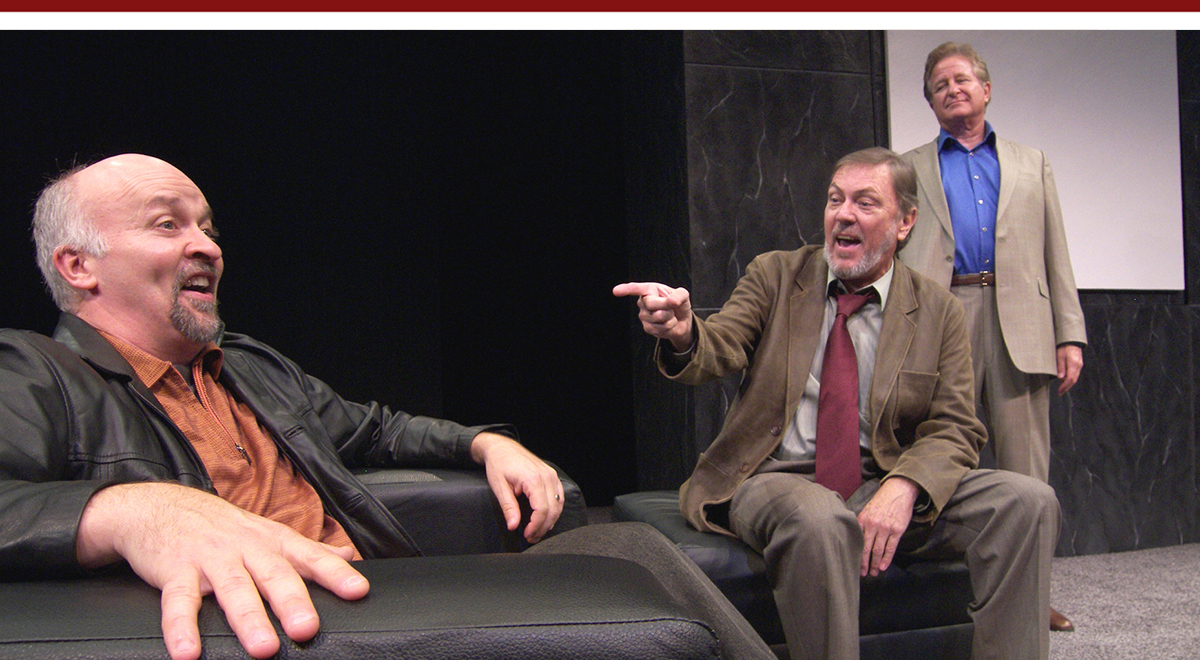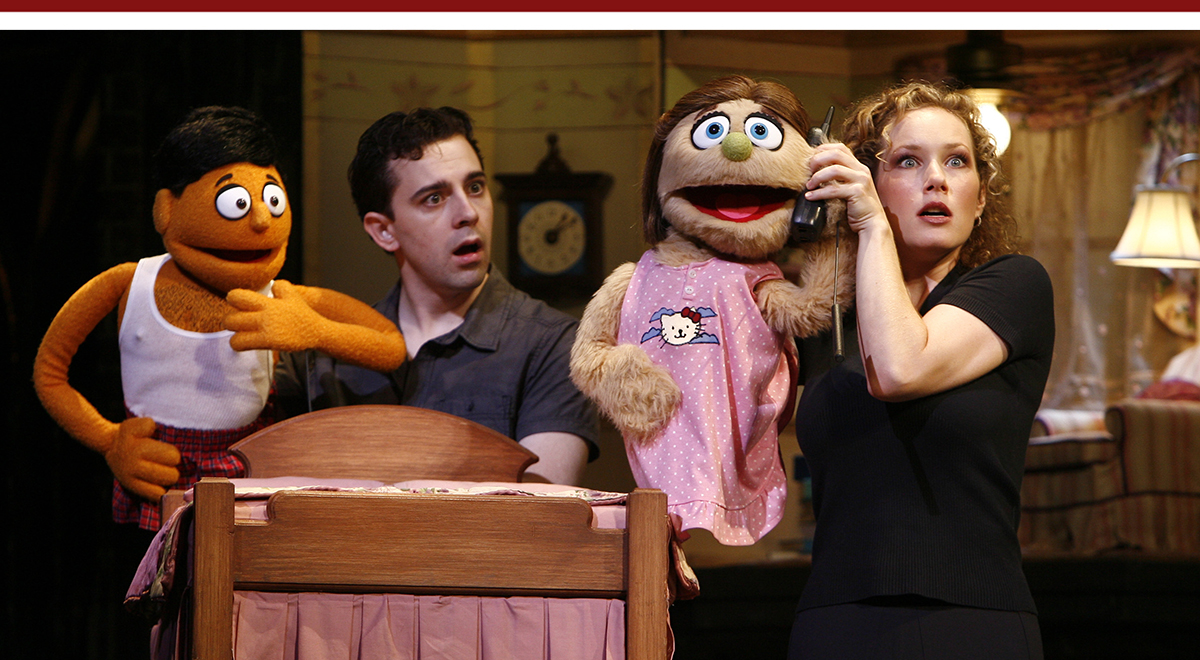SEPTEMBER 2007
Click title to jump to review
THE ADDING MACHINE by Elmer Rice | La Jolla Playhouse
AND NEITHER HAVE I WINGS TO FLY by Ann Noble | The Road Theatre
ART by Yasmina Reza | Laguna Playhouse
AVENUE Q music and lyrics by Robert Lopez and Jeff Marx, book by Jeff Whitty | Ahmanson Theatre
CALLING APHRODITE by Velina Hasu Houston | International City Theatre
DURANGO by Julia Cho | East West Players
A LITTLE NIGHT MUSIC music and lyrics by Stephen Sondheim, book by Hugh Wheeler | South Coast Repertory
MATTER OF HONOR by Michael J. Chepiga | Laguna Playhouse
SWIMMING TO THE MOON by Gary Flaxman | Art/Theatre
THIRD by Wendy Wasserstein | Geffen Playhouse
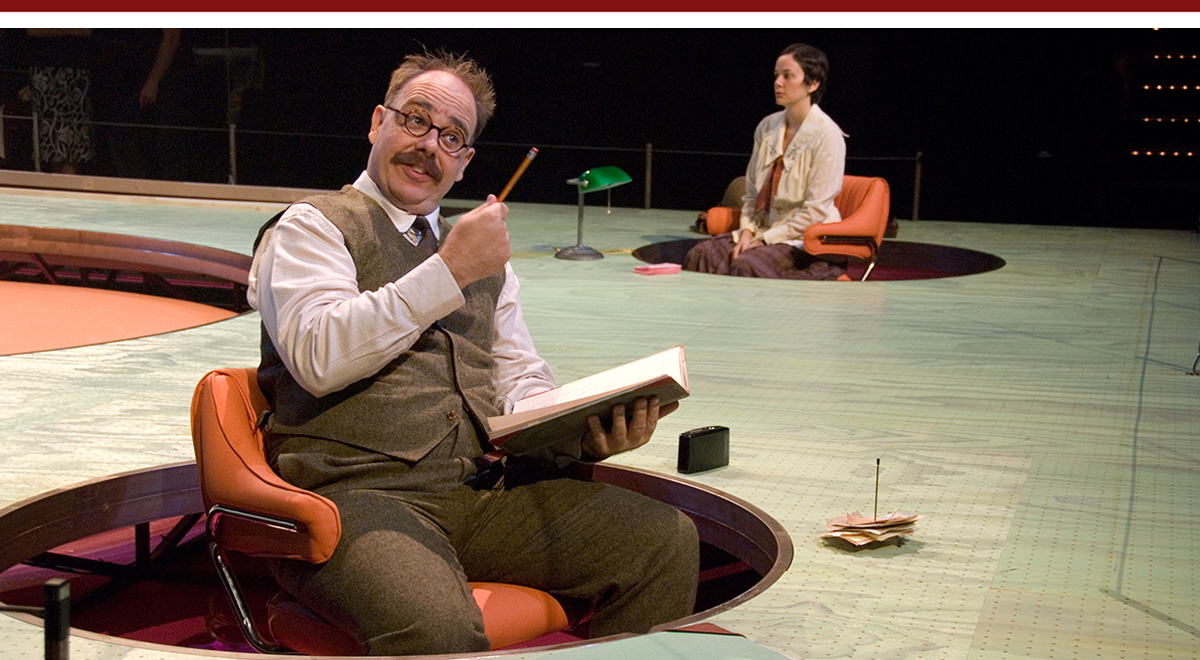
Some total
Midway through the La Jolla Playhouse's 60th Anniversary season, watchful spirits – possibly organized by Leslie J. Cohen, the late, longtime Playhouse friend and Trustee to whose memory the production is dedicated – have rallied for a landmark production that serves as signpost to past and perhaps future greatness.
Like the reincarnation given Brecht, Chekhov, Sophocles and others during those heady McAnuff start-up years, Daniel Aukin's computer-age understanding of Elmer Rice's 1923 The Adding Machine is a total success greater than the sum of its parts.
With Technicolor vision and a deft grip on both concept and performance style, Aukin has guided a cast led by Richard Crawford to a feast of inventive theatricality with a social stinger.
Holding up without hammering out the aspects of a prescient script by the Pulitzer Prize-winner (for the later Street Scene), Aukin steers well clear of what would make for a long night in the heavy hands of a director bent on making an audience pay for its bourgeois sins. Still, a theater audience, especially a feted opening night crowd, is likely to be more of industry's top than bottom. So to insure that Machine's message about employing understanding with workers is doggy-bagged for revisiting, he injects it into a staging as cool and colorful as sorbet.
Mr. Zero (Crawford, right out of a Max Fleischer cartoon) is a cubby-holed cog at work, totaling figures called out by a co-worker, Miss Devore (a Tautou-esque Diana Ruppe). After 25 years of adding to a firm bottom line, the firm has added nothing beyond subsistence for him. Consequently he must endure the whiney tirades of Mrs. Zero (Jan Leslie Harding, another sight gag), who is the rightful needler on her own nightly phonograph record. As Zero slumps in his Lazy Boy, Harding's pitch-perfect bitch drones what would drive any spouse to embrace the electric chair. Yet, in Aukin's and Harding's hands, it remains endurable and funny, even wryly moving.
A healthy percentage of the credit for this production's success – depending on who brought the ideas to the design meetings – must be shared between Aukin and his designers: scenic designer Andrew Lieberman, costumer Maiko Matsushima, lighting designer Japhy Weideman, the sound designer and composer, Colbert S. Davis IV and Cassia Streb, respectively, and even Mark Adam Rampmeyer's wigs and hair treatments.
Leiberman's platform set is as symmetrical as a boxing ring. The stage floor, bathed in the tropical punch hues of Weideman's lighting cues, has five table-size cutouts. It creates an ironically gorgeous environment for Zero's strange, expressionistic rabbit hole plunge. After 25 years of serving the company, and assuming the loyalty goes both ways, the worker sees that his investment has left no mark. He takes matters into his own hands after a dinner party for the other office numbers reveals, in Aukin's most stylized staging, that they are all nothing more than synchronized robots.
Without a chance of justice at work, and no longer able to muster any personal joy elsewhere in this world, Zero is shown the next one. There, Rice imagines, we are free to make our own heaven if we want it. But, Zero, and one badly damaged earlier arrival, Shrdlu (a riveting Joshua Everett Johnson), are, for different reasons, unable to take advantage. Even after Miss Devore appears, offering an appealing woman's heaven, Zero is just too numb, and opts for a return to the grindstone's ball and chain.
A must see for anyone curious about Rice and his work. According to Associate Artistic Director Shirley Fishman, who championed the script, there are no tweaks (just some cutting of repetitious passages near the very end). It's a thrill to hear that good insight into the human condition is timeless, even if it means we as a society haven't progressed as far as we'd like to think.
In terms of the Playhouse's progress, it's clearly back on track. I think a night raid is in order to move the "true north" marker that begins the Ashley era from 'Carmen' to this show. I'm sure Mr. Cohen's up for it.
top of page
THE ADDING MACHINE
by ELMER RICE
directed by DANIEL AUKEN
LA JOLLA PLAYHOUSE
September 11-October 7, 2007
Opened, rev’d 9/16
CAST Walter Belenky, Richard Crawford, Molly Fite, Jan Leslie Harding, Liz Jenkins, Joshua Everett Johnson, Rufio Lerma, Diana Ruppe, Paul Morgan Stetler, Peter Wylie
PRODUCTION Andrew Lieberman, set; Maiko Matsushima, costumes; Japhy Weideman, lights; Colbert S. Davis IV, sound; Cassia Streb, music; Mark Adam Rampmeyer, wigs/hair; Steve Rankin, fights; Anjee Nero/Heather Toll, stage management
Richard Crawford and Diana Ruppe
J.T. MacMillan
The course and the fine
Her hair and skin suggest that playwright Ann Noble has Ireland in her bones. But more importantly for audiences at the current Road Theatre Company production of her And Neither Have I Wings to Fly, Ireland and its theater traditions are in the bones of her writing. Consequently, her one-set, one-family drama is built of sturdy storytelling technique, effectively exploring how people struggle to recognize and then loose the tethers that keep them from crossing the wide water of their potential.
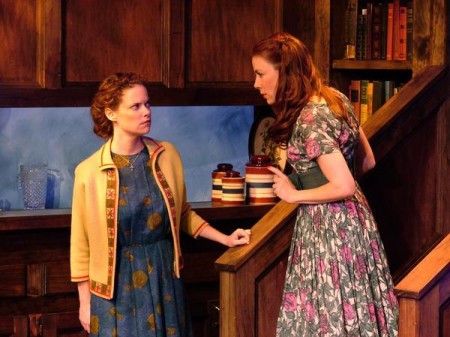 Iconic Irish elements like liquor, literature, good luck and bad -- but not delimiting themes of church or political 'troubles' -- give the play more universal relevance. Set in the 1950s, the only hand props are those used to eat, smoke, drink or read. It frees the play from period, and allows a vibrancy that comes from a love of storytelling shared by the writer and her characters. It’s the running stitch that gives ‘And Neither’ the tight weave and timelessness of Irish lace.
Iconic Irish elements like liquor, literature, good luck and bad -- but not delimiting themes of church or political 'troubles' -- give the play more universal relevance. Set in the 1950s, the only hand props are those used to eat, smoke, drink or read. It frees the play from period, and allows a vibrancy that comes from a love of storytelling shared by the writer and her characters. It’s the running stitch that gives ‘And Neither’ the tight weave and timelessness of Irish lace.
The action occurs in the week after Moira Donnelly’s death following a three-year illness. It’s the week that Eveline (Noble), the older of the two surviving daughters, is ignoring a deadline to enroll in a university literature program. A scholarship to pay for the courses, also expiring, remains hidden from her father, Peter (Leon Russom), and sister Kathleen (Stephanie Stearns). The three mourners are left to focus instead on Kate’s imminent wedding to Leo (Danny Vasquez).
Freddy Malone (Mark Doerr), an actor who met Kate the previous summer while touring ‘Tartuffe,’ arrives to announce he’s back with a tour of ‘Hamlet.’ His seemingly innocent visits to drum up audiences cover an increasingly obvious desire for Kate. Leo’s brother Charley, a frequent gaol guest and roustabout (a bit squeaky clean in Mark St. Albans’ otherwise wonderful performance), shows up for the wedding with an obvious chance at romance for the shut-down Eveline, as well as some useful insight into Freddy’s claims of fame.
It’s a lot of plot, and there are times in the first act, as the different strands are laid out, that it hardly seems possible that Noble can give them their due. But she manages to keep them all trimmed and in line, in part because she keeps what might have become the core story – Eveline's relationship with her mother’s ghost (Taylor Gilbert) – a sidelight, and focuses instead on how the sisters service or squander their passions.
The entire cast soaks their lines in a natural, uniform brogue supervised by Linda de Vries. For her part, Stearns allows the relationship with Freddy to evolve unseen. The way her playfulness continues to be excused by characters and audience creates a seamless descent into a terrible dilemma. It’s a nice achievement when a two-and-a-half hour play realistically portrays the kind of slow slide that takes weeks or months in real life. It’s one of the pleasures of Scott Cummin's immensely watchable staging.
The other half of the story’s center is Eveline. The role is even trickier, since Eveline is written as such a locked-heart-and-tossed-key case. Seeing when the crack in the armor occurs, without making it obvious, is the challenge. Perhaps better sensing one of those unseen shifts could come in her first real exchange with Charley. This is the pivotal moment where the script opens the door for the nature of the next encounter. But Eveline is as stoic as stone masonry. One can easily justify the blankness. But the origin of Eveline’s emotional lock down needs more insight. As does the reason Eveline so easily caves in to Freddy’s entrance, after she goes to bar him.
While we feel the spirits of Synge and Friel in the room, Noble beautifully annexes Ibsen territory. And a century after a similar caretaker named Pegeen Mike collapsed upon losing her ‘Playboy of the Western World,’ Eveline not only wins her playboy's heart in Charley, she immediately risks losing him so she can find herself. A well integrated nod to progress in a work that retains such a wide timespan.
The title is taken from ‘The Water is Wide,’ a 400-year-old English song that has been recorded by major artists like James Taylor, Linda Ronstadt and Bob Dylan. And as the play nears its end, many of the memorable images and events are recalled in the song’s lyrics delivered in a duet by Rossum and Gilbert. As they work through the verses, the evening's stories are recalled and folded, like that Irish lace, back into an area the size of a song. Perhaps the only thing more emotional than a well-rendered Irish story is an Irish song. Noble gets her desired effect. I’d swear I saw an 11 or 12-year-old lad daubing his ducts as the curtain call cue came up.
Now there’s a theater award.
top of page
AND NEITHER HAVE I WINGS TO FLY
by ANN NOBLE
directed by SCOTT CUMMIN
ROAD THEATRE COMPANY
September 9-November 14, 2007
Opened, rev’d 9/14
CAST Mark Doerr, Taylor Gilbert, Ann Noble, Leon Russom, Mark St. Amant, Stephanie Stearns, Danny Vasquez
PRODUCTION Desma Murphy, set; Gelareh Halioun, costumes; Henry Sume, lights; David B. Marling, sound; Lee Osteen II, music; Maurie Gonzalez, stage management
Ann Noble and Stephanie Stearns
Matt Kaiser
The oy of the beholder
A modern painting that pushes the limits of credulity for two of three best friends, stress tests their relationships and opens an exploration of male bonding in Yasmina Reza’s famous Art, which opened over the weekend at the Laguna Playhouse under Andrew Barnicle’s direction.
Art, forever embossed for those who saw it by the Broadway production with Victor Garber, Alan Alda and most indelibly Alfred Molina, still has plenty of power to stimulate audiences. The potential for insight in follow-up productions like Laguna's attractive mounting, rests with the chemistry of the actors.
Barnicle has cast Steve Vinovich as Serge, a middle-aged divorcée who has spent a fortune to own a decades-old painting by a hot, if trendy artist. Its canvas is so subtly painted, textured and designed that it looks completely white to his friends (and, on Dwight Richard Odle's sleek set, to the audience). John Herzog is Marc, the married, intellectual, self-appointed alpha male of the group. Marc is launched to high dudgeon as soon as he sees the painting. Because all modern art is outside his comfort zone, he sees this art as an act of secession by a man he saw as a mentee. The third and shortest leg on Reza’s buddy-stool is Ivan, played by Kyle Coleridger-Krugh. Ivan, who will soon be married to a woman the others paint as domineering, is soon revealed as an inveterate invertebrate when it comes to friend or fiancé.
As a fan of Vinovich after enjoying him in Pacific Resident Theatre’s ‘The 60s,’ I liked his affable approach to Serge. Herzog portrays Marc as more bitter and humorless than I’ve seen him– either by Alda or SCR’s John de Lancie. Consequently, without a visible clue to what made him worth warming up to originally, he really seems to be overstepping his boundaries in the selfish manipulation of his friend. He's appears to be less about helping a friend out of an 'Emperor's New Clothes' episode, and more about re-establishing his own mastery as mentor. Without better balance between the two, Marc's declaration that, “I detest your independence. You’ve abandoned me” pretty much answers the question of who's out for his own ends. To the extent that a script is a blank canvas and actors color their characters, who gains the upper hand in any accusation of folly may come down to who is the more likeable character. Who would you want to end the night as a friend? Here, the house favors Vinovich’s Serge.
As Ivan, Coleridger-Krugh is outside the basic battle, trying to avoid being dragged in. So Reza gives the actor a couple of lengthy, funny monologues. The actor delivers them well by and gets a deserved round of applause.
A fundamental ingredient of traditional painting is perspective, created by use of vanishing points. The point of ‘Art’ hasn’t disappeared, even if it is a little cloudy here. Art is personal; art is universal. That’s what attracts Serge to his painting and should drawn audiences to this production. The familiar male jockeying for validation and primacy are subtly etched, and Barnicle keeps the focus in the right place as we watch them circle each other. But like the not-quite-white painting, the conversation can appear one dimensional if not in the right light. Just because something is made of a single color, it doesn’t need to be monotonous.
top of page
ART
by YASMENA REZA
translate by CHRISTOPHER HAMPTON
directed by ANDREW BARNICLE
LAGUNA PLAYHOUSE
September 11-October 14, 2007
Opened 9/15, rev. 9/16m
PRODUCTION Dwight Richard Odle, set/costumes; Paulie Jenkins, lights; David Edwards, sound; Vernon Willet/Victoria A. Gathe, stage management
John Herzog, Steve Vinovich, and Kyle Coleridger-Krugh
Christopher Trela
Street of dreams
It has taken four years for the musical theater block party called Avenue Q to reach Los Angeles. In 2003, composer-lyricists Robert Lopez and Jeff Marx and book-writer Jeff Whitty premiered their show at off-Broadway's Vineyard Theatre under Jason Moore's direction. The combination of the kind of irreverence that earns cult status for films, bubble-wrapped in Children's Television Workshop references, earned critical praise, gushing word-of-mouth and a move to Broadway.
After it won 2004 Tony Awards for best musical, score and book, a lone road company was sent to establish a beach-head in Las Vegas. But that proved a dead-end when the few naughty bits (like a scene in which puppets have sex) was just too much for families more comfortable with Vegas' traditional offerings of gambling and nudity. So, this year Avenue was back on track, hitting the road in a national tour that now parks at the Ahmanson Theatre through October 13.
Modeled after the PBS show "Sesame Street," Avenue Q has an educational vibe that underlies all the life lessons in Whitty's never-formulaic dialogue, the helpful cartoon videos by Lopez, and more than 20 pop tunes sung by the cast of humans and puppets. The puppets, who recall characters like Cookie Monster, Bert and Ernie and others, are not here to help kids, however. They're just here to help co-opt the most successful franchise in children's television, creating a kind of foam-rubber Rent by which to explore those baffling years between leaving home and buying our own.
Issues associated with setting out on our own, like confusion over identity, sexuality, values and purpose are the stuff of people in their 20s and 30s. Here, thanks to this aura of children's programming, the writers take license to say anything. They apply the directness and innocence of kids, who haven't lived long enough to watch what they say, to the neurotic world of adults, who seldom say what they feel. The incongruity of children's puppets singing "You Can Be as Loud as the Hell You Want (When You're Makin' Love)" and "The Internet is for Porn" fills Avenue Q with a giddy anarchy. These songs, and others like "We're All A Little Bit Racist," are more in-your-face and incendiary on paper than they play, which probably explains the unusual step of not listing the musical numbers in the program.
The primary story follows the puppet Princeton, brought to life by Robert McClure, a 23-year-old trying to find his purpose in life before making any professional or personal commitment. His affections become divided between the nurturing Kate Monster, a good girl from the other side of the gene pool, and a trampy seductress named Lucy the Slut. Kelli Sawyer provides the hands and voice for both. In addition to Princeton's story line, there's one involving roommates Rod and Nicky as Rod discovers his true sexual orientation and Nicky gets thrown out on the street when he seems unsympathetic.
The cast's three humans include Christmas Eve, a Japanese immigrant played by Angela Ai, her boyfriend Brian, a wannabe stand-up comedian played by Cole Porter (yes, that's his name), and Gary Coleman, played by Carla Renata. It's the Gary Coleman, the former child television star after his fortune was squandered. Now he manages one or more of the buildings on Avenue Q.
The cast delivers the songs, the comedy, the muppet voices and the everything's-okay cheeriness demanded by the show's conceit (even when it's barely noticeable beneath a sad or dramatic section). Sawyer and McClure, who get the big numbers that carry more story and emotion, are the stand-outs.
The way the four puppeteers work the half-dozen puppet characters adds to the show's sense of candor and honesty. Just as kids play with dolls by wriggling the frozen-faced things while they provide voice and expression, the 'Avenue Q' puppeteers make no effort to hide their presence. Like ventriloquists who forgot to keep their mouths shut, they act out each line of dialogue as their hands animate the characters' faces. Even Minglie Chen, who is the second puppeteer in a couple of the more elaborate puppets (like Nicky), acts out the lines in tandem as the lead puppeteer, usually Christian Anderson, provides the voice.
The bizarre dichotomy is best represented by the Bad-Idea Bears, a pair of syrup-falsettoed Teddies who pop up to offer advice at key moments. But these two are not here to coach virtue. They want people to stay out all night and pout when their human friends can only afford a six-pack instead of a case of beer.
Unless your 10-year-old has just returned from a year at sea, this is probably too salty for the kids in the family. Still, if you love musical theater, you'll want to study how a show that begins with a tune called "My Life Sucks" and ends with one about how unsatisfactory things are, can provide one of the most uplifting experiences in theater this year. On the other hand, if you loved watching the Muppets for their barely contained subversive undercurrent, this is a must. It's like the Broadway staging of what Jim Henson and Frank Oz might have come up with in their heydey, after they'd put the censors to bed and brought out the good hash.
top of page
AVENUE Q THE BROADWAY MUSICAL
music and lyrics by
ROBERT LOPEZ and JEFF MARX
book by JEFF WHITTY based on an original
concept by Lopez and Marx
music supervision, arrangements, and
orchestrations by STEPHEN OREMUS
choreography by KEN ROBERTSON
book by JASON MOORE
AHMANSON THEATRE
September 6-October 13, 2007
Opened 9/7, rev. 9/7
CAST Angela Ai, Christian Anderson, Minglie Chen, Robert McClure, Cole Porter, Carla Renata, Kelli Sawyer
PRODUCTION Anna Loulzos, set; Mirena Rada, costumes; Howell Binkley, lights; Acme Sound Partners, sound; Robert Lopez, animation; Gary Adler, incidental music, Andrew Graham, musical direction; Marian DeWitt, stage management
HISTORY Produced by Kevin McCullum, Robyn Goodman, Jeffrey Seller, Vineyard Theatre, The New Group
Princeton, Robert McClure, Kate Monster and Kelli Sawyer
Carol Rosegg
War torn
Leave it to a woman who owes her existence to a love that owed its existence to war, to write a play that brings together those opposing forces. Calling Aphrodite, Velina Hasu Houston's unifying new drama, is receiving its world premiere under Shashin Desai's direction at the International City Theatre in Long Beach (through September 23).
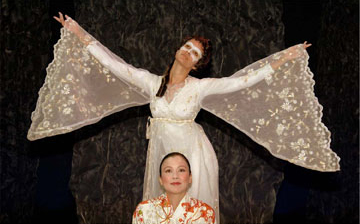
The director's light touch in design and performance has made the most of this coup for his theater, allowing a beautiful play to breath and radiate meaning on many levels. His two leads tailor finely drawn characters, always allowing the words and images within the script to do the heavy lifting.
For Aphrodite, Houston - whose Japanese mother and African American father met in Japan after the war - returns as she did in her best-known work, Tea, to those years leading to her birth. There, as here, she explores the way Japanese women had to adjust their sense of personal and cultural aesthetics in the tangled wreckage of the post-war world. In Tea, the women have followed their soldier husbands back to a base at the center of America and formed their own kind of island nation within the foreign culture.
Calling Aphrodite introduces two sisters reaching adulthood in 1940s Hiroshima. Keiko (Kym Hoy) is older than Shizuko (Vivian Bang) by a couple of years. Though she is constantly complimented on her surface beauty, dressing in traditional kimono as if to underscore its timelessness, she is more concerned with deeper meanings of the phenomenon, and explores those questions in inner dialogue with Aphrodite (Brenda Hattingh), an expert on the subject.
The story follows the sisters and two doctors, the American Dr. Everett (Barry Lynch), who served U.S. troops during the war and now tries to help traumatized Japanese, and their local Hiroshima physician (Blake Kushi). Keiko begins the play enamored of American culture, particularly films starring Susan Hayward. Even though her country and the U.S. are at war, Keiko can separate these nations' exhibition of love and beauty from their engagement in war and domination.
Until the bombs drop. Then the challenges of maintaining her distinctions of beauty and integrity between hostiles are put to the ultimate test. Houston integrates classic themes of beauty, war, love, tragedy and so on without ever blurring her portraits of real women. When one chides the other with, "You only loved what he looked like," we're hearing the stuff of myth wrapped in a teenage taunt.
Similarly, the central question of beauty's mixed blessing echoes in larger contexts. Keiko and Shizuko think the American planes have spared their city because of its natural beauty. Once the land and people have been ravaged, they wonder if beauty abetted the enemy because the weather was perfect over Hiroshima that day compared to other cities obscured by clouds.
The less-is-more use of masks is also a plus. Aphrodite is "covered" only by a white eye mask, as if she peeped through the mail slot of a door being spray-painted. Productions suffer when actors' faces are covered, eliminating the most animated agent on stage. Thankfully Desai resorts to a full mask only briefly. Instead, we get a more powerful sense of theatrical masks and the real-life masks of enhancing make up or disfigurement by scars.
The cast is anchored by its leads, Hoy and Lynch, who navigate what could slide into treacly melodrama in the wrong hands.
One dramaturgical note is a possible red herring in Dr. Everett's references to his wife, who first fails to accompany him, then separates from him, and is then back in his life (or he has remarried) without any apparent need for this arc. Though it never gets in the way of the storytelling, it hints that Houston may have been laying the groundwork for Keiko to allow herself thoughts of a deeper emotional connection with him. A romance between doctor and patient is not where this play wants to go, but the internal workings of a once-beautiful woman reckoning her powers after damage to her image, is the area Houston has in her sights. A word to Keiko that they are back together, without disturbing the non-relationship, might be what the story wants. And, since Everett's only age requirement is that he have a son of military age, if in future productions a director casts Lynch as young as late 30s or 40, this angle would have to be sorted out one way of the other.
As Calling Aphrodite unfolds we feel the sure hand of a playwright whose interest in craft is matched by her interest in humanity. When both aspects are at this high a level, theater opens both the hearts and minds of its audience members. She is fortunate to have such a production with which to launch it.
From the opening pluck of ancient Japanese instruments, the balletic first entrances, and the framing of Don Llewellyn's beautiful, furniture-less set we experience an integrated production that totals more than the sum of its parts. Credit Desai with making the most of a great opportunity to premiere the work of an important American writer.
top of page
CALLING APHRODITE
by VELINA HASU HOUSTON
directed by SHASHIN DESAI
INTERNATIONAL CITY THEATRE
August 20-September 23, 2012
(Opened 8/31; rev'd 9/6)
CAST Vivian Bang, Brenda Hattingh, Kym Hoy, Blake Kushi, Barry Lynch
PRODUCTION Don Llewellyn, set; Kim DeShazo, costumes; Jeremy Pivnick, lights; Glen A. Dunzweiler, sound; Kevin O'Brien, visual design; Pamela Berlin, dramaturg; Mary Trahey, make-up; Kathleen Hager, stage management


